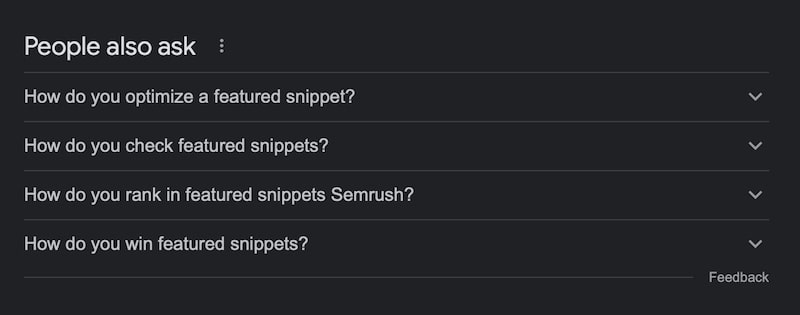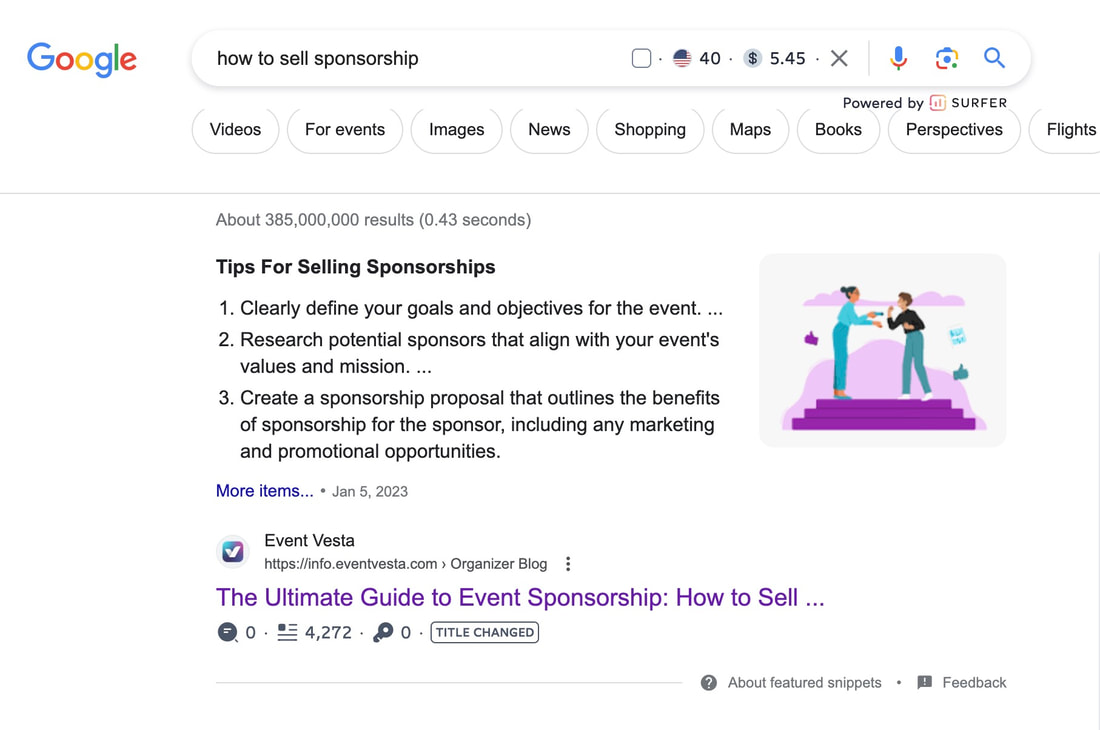|
While ranking on the first page of Google is certainly an accomplishment, there is one thing that seems to elude many marketers: getting the coveted featured snippet. The featured snippet on Google is a short web snippet that appears at the top of the search results, before the link to the first result. It can also appear in the “People Also Ask” section. Oh hey! It's me, Craig, hopping in here real quick on Andrew's guest post. I've seen first hand in my 10+ years of SEO work how much these featured snippets can help expand reach. Here's a quick example from Event Vesta where I've helped our blog search traffic climb to 1k+ per month in qualified visitors after one year. This example is just to show the newer, expanded featured snippets, and how those work. It's for the search term "how to sell sponsorships," The featured snippet is prominent and in-your-face, leading to a much higher click-through rate. Landing in the featured snippet also leads to many more organic backlinks and local citations. Google’s algorithms use several factors to determine which articles have information that would make an excellent featured snippet. While there’s no guarantee that you’ll land in the featured snippet, optimizing your blog post for it will significantly increase the chances of it happening. Here are eight ways to optimize your content for featured snippets. Do this in every article you publish, and you have a pretty good chance of landing in at least some featured snippets. 1. Gather Keywords You Want to TargetYour first step should be to decide which keywords to include in the paragraph optimized for the featured snippet. It’s important to differentiate between the featured snippet and the meta description. The meta description is the part that will appear after your link in the Google search results, and it summarizes your article. All articles have a meta description appearing after the link. The featured snippet only appears in some Google search results, and there is only one featured snippet per Google search. It appears before the link, not after. While your meta description should be between 140-160 characters, the featured snippet should be between 40-50 words, the most common length of featured snippets. As you only have 50 words to work with, you have to choose your keywords carefully. Even if you target many keywords in your article, you can only include 1–5 in your featured snippet. The more keywords you stuff in there, the more you risk making the snippet sound unnatural. Use a keyword tool like SEMrush or Ahrefs to help you settle on which keywords to include. They should be the keywords that you want to target the most – the ones that relate the most to your content and have the highest conversion rates. You should also have a good chance of ranking for them (they should have low competition). 2. Identify the Snippets Acquired by Your CompetitorsYour next step should be to look at the featured snippets acquired by your competitors. Start by simply running a search for your top keywords and noting the featured snippets already appearing. You can beat your competitors and push them out of the featured snippets, replacing their content with your content. However, you have to create better content than them, and you need a featured snippet that better answers the question of the Google searcher. So, look at those featured snippets and try to find what they are lacking. Think about the answers the average Google searcher is looking for. Is the featured snippet missing something that needs to be said? If you see one or two competitors constantly acquiring featured snippets, it’s worth analyzing their strategies and figuring out what they are doing right. Is there a certain format they are sticking to? In general, it’s worth identifying trends in featured snippets to learn what works. 3. Make Sure Your Content Is Better Than the CompetitionFor your articles to acquire a featured snippet in the search results, they must be better than your competitors’ articles. It’s not just the featured snippet that needs to be better optimized – it’s the entire article. Make your articles longer than the other articles already ranking for your target keyword. The more content you put in the article, the better your chances of some of that content getting into the featured snippet. Include more information and add more images. 4. Organize Your Content IntelligentlyIt’s critical to organize your content so that it has a better chance of getting the featured snippet. A good rule of thumb for most informational articles is to optimize your second paragraph for the featured snippet. The first paragraph should be a leading paragraph. It should quickly repeat the issue that the article is coming to discuss. For example, if the article title contains a question, the first few lines should repeat and expound upon that question. The second paragraph should then answer the question. Give a clear and concise answer or explanation. If the title contains a question, start the second paragraph with a “yes” or “no.” The second paragraph should summarize the entire article. After all, that’s what the featured snippet is about – giving users a quick and concise answer to their questions. Remember, you want to include at least 40 words, but no more than 50. The second paragraph shouldn’t be more than a few sentences long, and you should consider bolding it. 5. Match the Format for the SnippetMatch the format of your article to the leading snippet (the second paragraph). In other words, break down the article into subheadings based on that second paragraph and the order of its sentences. This is especially important for listicles or how-to articles that contain several steps. For such articles, Google often ignores your optimized paragraph and instead uses your numbered subheadings in the featured snippet. It’s still worth writing that second paragraph and optimizing it for the featured snippet. 6. Understand Search Intent and Answer Questions AccordinglyGoogle tries to include a featured snippet that best answers the question in the search term. Therefore, to get that featured snippet, you need to accurately understand the search intent for your target keyword. What exactly is the main issue that someone typing that search term into Google faces? What is a significant secondary issue the average searcher has? Typically, it’s not readily apparent from the keyword itself – it requires a bit of additional thought. It also requires you to think about the demographics of the searcher and the situation they might currently find themselves in. You need to figure out how much information they already know about the topic, too. That is critical, because you don’t want to state obvious information in your featured snippets. If you include information they already know, it won’t answer their questions, and you’ll miss out on the chance of appearing in that featured snippet. Answer the question clearly. Include as much information as possible, while keeping your paragraph to 40-50 words. 7. Answer Multiple Questions About the TopicI mentioned how it’s important to think about secondary questions people may have when typing in a specific search phrase. That’s because if you want to be the “top answer” to that search term and land yourself in the featured snippet, you’re going to have to answer all the questions that the search term implies. In your optimized second paragraph, try to answer at least 1-2 secondary questions about the topic. Think about the most pressing secondary questions that people have, and focus on those in the paragraph optimized for the snippet. However, in the rest of the article, you can answer many more questions. Create as many subheadings as you need, using H2, H3, and even H4 tags to give your article a structure and break it down, making it easier to read. Include questions in those H2 and H3 subheadings. Even if your optimized paragraph doesn’t make it to the featured snippet at the top of the page, you may still get into the featured snippets in the “People Also Ask” section. The “People Also Ask” section contains a list of additional questions people have on the topic, along with quick answers. Any of your subheadings may end up in that section. Therefore, when answering multiple questions in your article, always include a clear and concise answer in the first paragraph under each subheading before expanding upon the answer. That will make it more likely for one of those questions to end up in the “People Also Ask” section. 8. Test the Article and Make Necessary ChangesFinally, track your results and make changes as necessary. If you’re not landing in the featured snippet, try adding more questions in your article or rewriting the second leading paragraph. When some of your articles start making it into the featured snippet, try to identify trends, as mentioned above. What were you doing correctly in those articles that you were not doing in others? Use that information to fine-tune your writing when publishing new content or revising existing articles. Final ThoughtsNot all of your articles will end up in the featured snippet, and that’s okay. The important thing is to optimize all your articles for it. The more you land in the featured snippet, the more traffic you will get. Furthermore, getting into the featured snippet automatically boosts your authority and is great for your brand reputation. If Google trusts you as its main source of information, Google searchers will start trusting you as well. That will lead to increased conversion rates, including more subscribers, social media followers, and customers. Guest Author
0 Comments
Leave a Reply. |
PopularCategories
All
|




 RSS Feed
RSS Feed